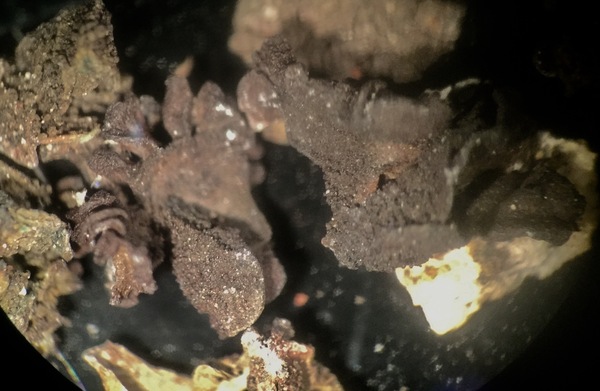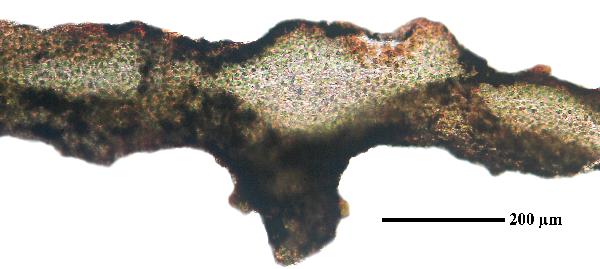Lichinella iodopulchra (Croz.) P.P. Moreno & Egea
Cryptogamie, Bryol. Lichénol., 13: 245, 1992. Basionym: Omphalaria iodopulchra Couderc ex Croz. - Bull. Acad. Int. Géogr. Bot., 19: 240, 1910.
Synonyms: Gonohymenia iodopulchra (Croz.) Henssen & P.M. Jørg.; Gonohymenia nummularia (Nyl.) Henssen nom. inval.; Omphalaria nummularia Nyl. nom. illegit.; Omphalaria pulvinata (Schaer.) Nyl.; Thyrea iodopulchra (Croz.) Zahlbr.; Thyrea nummularia (Nyl.) Zahlbr.; Thyrea pulvinata (Schaer.) A. Massal. non auct.
Distribution: N - Lomb (S-F146634). C - Tosc, Laz, Sar. S - Pugl (Nimis & Tretiach 1999), Cal (Puntillo 1996), Si (Nimis & al. 1996b).
Description: Thallus squamulose-umbilicate, small-foliose to subfruticose, gelatinous when wet, black, usually smooth, sometimes becoming uneven, the squamules 10-15(-20) mm wide, forming rosettes or cushions, at first flat and lobulate, soon becoming divided into erect, adpressed or ascending, 2-4 mm wide and 0.4-0.8 mm thick lobes with a narrow base, rounded tips and down-turned margins; lower surface attached by a central holdfast. Thallus 0.6-0.8 mm thick, the outer part formed by short-celled, 1.5-2.5 µm thick, mainly anticlinally oriented hyphae enclosing the photobiont cells, the medullary part of loosely arranged, 1-1.5 µm thick hyphae with cylindrical cells, lacking photobionts. Apothecia thallinocarps, hemiangiocarpous, the ascogonia arising freely beneath the thallus surface, sunken in thallus and difficult to recognize unless when wet, marginal to submarginal, filling the entire lobe tip, 2-4(-6) mm across, round to irregularly shaped, with a slightly flat to convex, dotted or fissured disc and a 50-100 µm thick thalline margin. Proper exciple indistinct or very thin; epithecium brownish, 20-30 µm high; hymenium 80-100 µm high, finally incompletely separated into partial hymenia by intrusions of wedge-shaped, sterile thalline tissue, covered by a continuous layer of sterile tissue separated only by the pore-like discs of the partial hymenia, K/I+ blue turning wine-red; paraphyses short-celled, 2-3 µm thick, not or only slightly capitate; subhymenium compact, 30-40 µm high, K/I+ blue. Asci 16-32-spored, subcylindrical to obclavate, prototunicate, with a thin, one-layered, non-amyloid wall, an amyloid external apical cap, and passive spore discharge via apical rupturing, Lichina-type. Ascospores 1-celled, hyaline, broadly ellipsoid, 5-9 x 3-5 µm. Pycnidia globose to broadly pyriform, immersed, unilocular, up to 0.2 mm wide. Conidia ellipsoid, 2-3 x 1-1.5 µm. Photobiont cyanobacterial, chroococcoid, with a few cells measuring 5-9 x 3-5 µm, penetrated by haustoria and surrounded by a brownish gelatinous sheath. Spot tests: all negative. Chemistry: without lichen substances.Note: on steeply inclined to vertical seepage tracks of more or less calcareous or basic siliceous rocks, most common in the Mediterranean belt. Most of the records of L. nigritella reported by Nimis from Southern Italy (1993: 422) belong here.
Growth form: Fruticose
Substrata: rocks
Photobiont: cyanobacteria, coccaceous (e.g. Gloeocapsa)
Reproductive strategy: mainly sexual
On otherwise dry surfaces with short periods of water seepage after rain
Commonnes-rarity: (info)
Alpine belt: absent
Subalpine belt: absent
Oromediterranean belt: absent
Montane belt: absent
Submediterranean belt: very rare
Padanian area: absent
Humid submediterranean belt: rather rare
Humid mediterranean belt: rare
Dry mediterranean belt: rather common

Predictive model
Herbarium samples
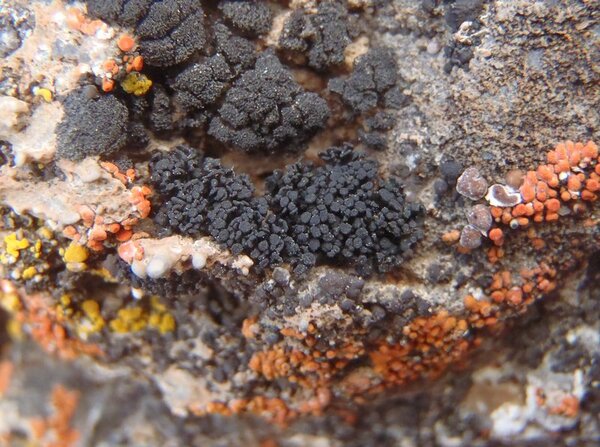

Curtis Randall Björk – CC BY-SA 4.0
Idaho, Butte County, north of Arco, North Creek Date: 2012-05-08 On calcareous breccia in sagebrush steppe
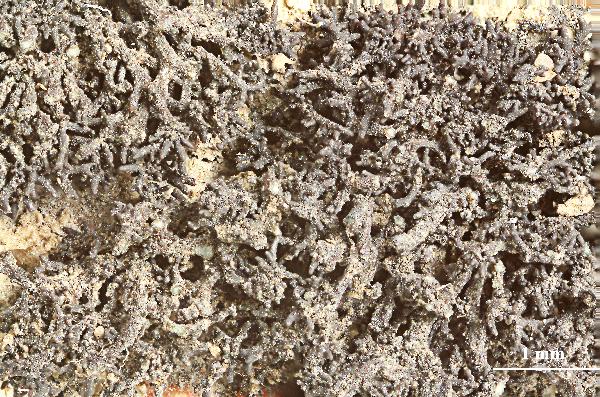

Felix Schumm - CC BY-SA 4.0
[ABL79369], Brazil, Rio Grande do Sul, Cangaçu, Baixada do Rodeiro,
Rio Pantanosa, on exposed siliceous rock. 31°14’20’’ S, 52°43’57’’
W, 260 m. Leg. A. Aptroot (no 79369), 16.07.2019, det. A. Aptroot,
2019.
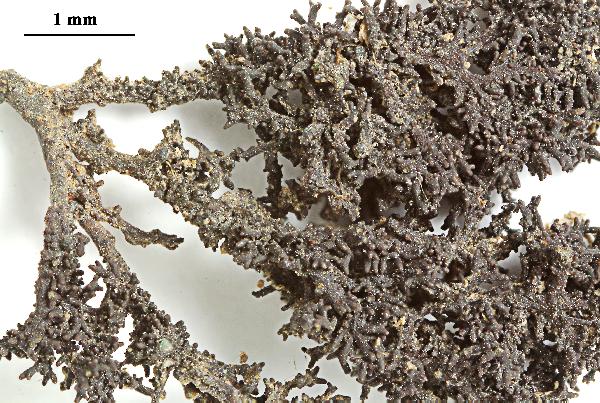

Felix Schumm - CC BY-SA 4.0
[ABL79369], Brazil, Rio Grande do Sul, Cangaçu, Baixada do Rodeiro,
Rio Pantanosa, on exposed siliceous rock. 31°14’20’’ S, 52°43’57’’
W, 260 m. Leg. A. Aptroot (no 79369), 16.07.2019, det. A. Aptroot,
2019.
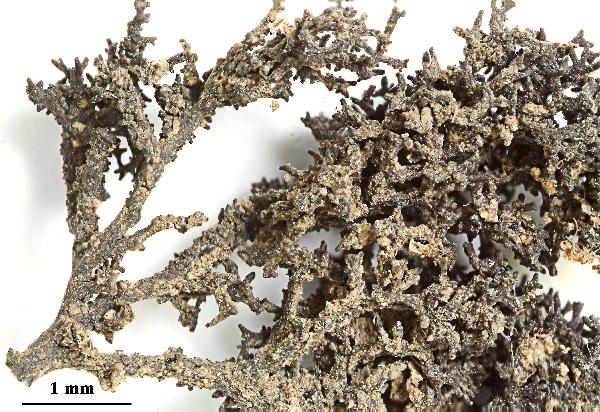

Felix Schumm - CC BY-SA 4.0
[ABL79369], Brazil, Rio Grande do Sul, Cangaçu, Baixada do Rodeiro,
Rio Pantanosa, on exposed siliceous rock. 31°14’20’’ S, 52°43’57’’
W, 260 m. Leg. A. Aptroot (no 79369), 16.07.2019, det. A. Aptroot,
2019.
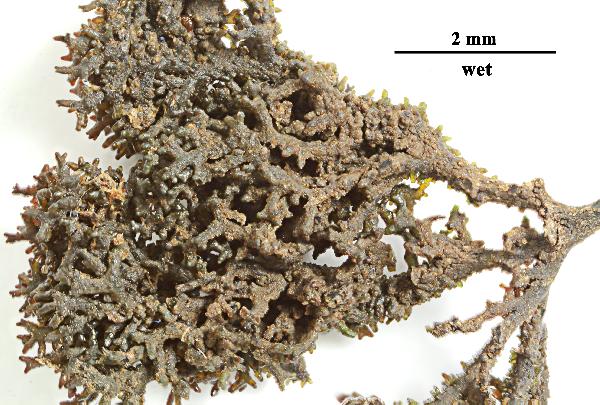

Felix Schumm - CC BY-SA 4.0
[ABL79369], Brazil, Rio Grande do Sul, Cangaçu, Baixada do Rodeiro,
Rio Pantanosa, on exposed siliceous rock. 31°14’20’’ S, 52°43’57’’
W, 260 m. Leg. A. Aptroot (no 79369), 16.07.2019, det. A. Aptroot,
2019.
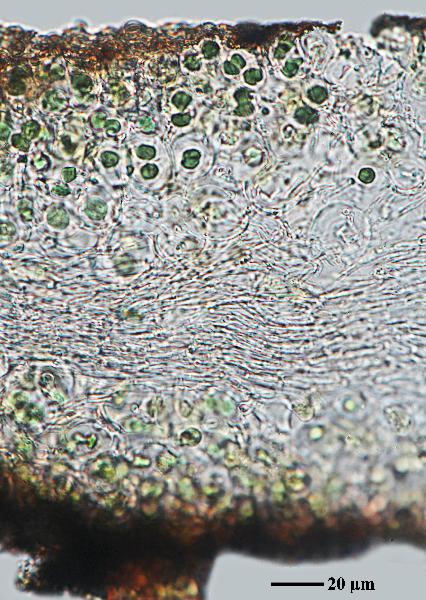

Felix Schumm - CC BY-SA 4.0
[ABL79369], Brazil, Rio Grande do Sul, Cangaçu, Baixada do Rodeiro,
Rio Pantanosa, on exposed siliceous rock. 31°14’20’’ S, 52°43’57’’
W, 260 m. Leg. A. Aptroot (no 79369), 16.07.2019, det. A. Aptroot,
2019.
Growth form: Fruticose
Substrata: rocks
Photobiont: cyanobacteria, coccaceous (e.g. Gloeocapsa)
Reproductive strategy: mainly sexual
On otherwise dry surfaces with short periods of water seepage after rain
Commonnes-rarity: (info)
Alpine belt: absent
Subalpine belt: absent
Oromediterranean belt: absent
Montane belt: absent
Submediterranean belt: very rare
Padanian area: absent
Humid submediterranean belt: rather rare
Humid mediterranean belt: rare
Dry mediterranean belt: rather common

Predictive model
| Herbarium samples |


Curtis Randall Björk – CC BY-SA 4.0
Idaho, Butte County, north of Arco, North Creek Date: 2012-05-08 On calcareous breccia in sagebrush steppe


Felix Schumm - CC BY-SA 4.0
[ABL79369], Brazil, Rio Grande do Sul, Cangaçu, Baixada do Rodeiro, Rio Pantanosa, on exposed siliceous rock. 31°14’20’’ S, 52°43’57’’ W, 260 m. Leg. A. Aptroot (no 79369), 16.07.2019, det. A. Aptroot, 2019.


Felix Schumm - CC BY-SA 4.0
[ABL79369], Brazil, Rio Grande do Sul, Cangaçu, Baixada do Rodeiro, Rio Pantanosa, on exposed siliceous rock. 31°14’20’’ S, 52°43’57’’ W, 260 m. Leg. A. Aptroot (no 79369), 16.07.2019, det. A. Aptroot, 2019.


Felix Schumm - CC BY-SA 4.0
[ABL79369], Brazil, Rio Grande do Sul, Cangaçu, Baixada do Rodeiro, Rio Pantanosa, on exposed siliceous rock. 31°14’20’’ S, 52°43’57’’ W, 260 m. Leg. A. Aptroot (no 79369), 16.07.2019, det. A. Aptroot, 2019.


Felix Schumm - CC BY-SA 4.0
[ABL79369], Brazil, Rio Grande do Sul, Cangaçu, Baixada do Rodeiro, Rio Pantanosa, on exposed siliceous rock. 31°14’20’’ S, 52°43’57’’ W, 260 m. Leg. A. Aptroot (no 79369), 16.07.2019, det. A. Aptroot, 2019.


 INDEX FUNGORUM
INDEX FUNGORUM
 GBIF
GBIF
 DOLICHENS
DOLICHENS
